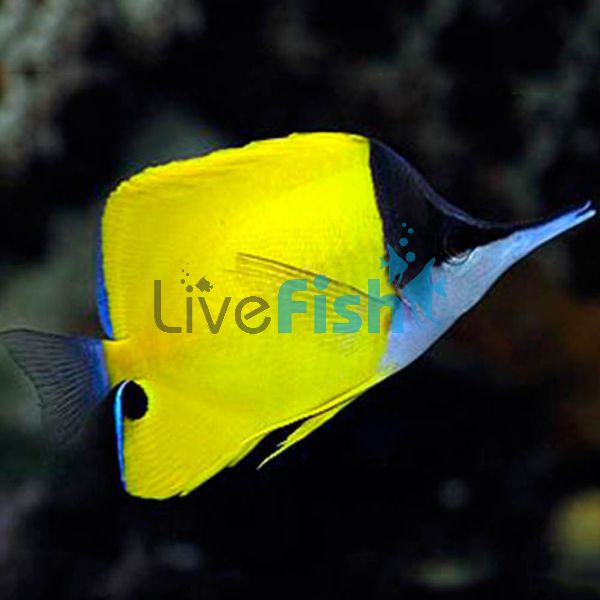Yellow Longnose Butterflyfish - Large
The Longnose Butterflyfish is the perfect first butterfly for an aquarium owner. Not only is it exceptionally beautiful but it is also extremely hardy, peaceful, and fun to watch.
Longnose Butterflyfish
A brightly coloured yellow fish gets its name from the extremely long snout mouth which it uses to pick up small morsels of food that hide in crevices. The black face mask and eyespot on their tails only add to their character.
There are no notable differences between sexes and although there has been some success in raising wild-collected larvae, efforts to breed this species in captivity have been fruitless.
Although the Long Nose Butterflyfish looks a little fragile, it is in fact an excellent beginner's fish. This is due to its peaceful nature and ease of feeding.
These fish live all over the Indo-Pacific region from East Africa to the Red Sea and all the way round to southern California, Mexico and the Galapagos Islands. They're often found in pairs (sometimes groups of 5+) inhabiting areas with lots of coral growth. They have been spotted at depths of 2-140 metres.
Tank Recommendations for the Long Nose Butterflyfish
The smallest tank size for a single fish is 280 litres. It will need plenty of swimming space along with living rocks that can be used to create nooks and overhangs. Avoid reef environments due to their varied natural diet of coral. These fish will do much better in a Fish Only or a Fish Only With Live Rock aquarium. These fish will swim freely all around the tank and will be much happier with a moderate amount of water movement and lighting.
Suitable Tank Buddies
The Longnose Butterflyfish is a peaceful species that will mix well with most other species as long as they won't eat it or become too aggressive.
Usually Compatible
This species will do well with Boxfish, Dragonets, Cardinals and Clownfish. Small and large species of Angelfish as well as Anglers, Batfish and Blennies will make great tank buddies too. Other excellent choices include Pufferfish, Parrotfish, Hawkfish and even Lionfish.
Sometime Compatible
Keeping these fish with other Butterflyfish is possible but be prepared to separate them if fighting occurs. Caution should also be take when housing with Filefish, Damsels and Eels. Wrasse, Triggerfish, Tangs and Scorpionfish should also be watched in case they become too boisterous. Most ornamental invertebrates will probably be eaten by the Butterflyfish so take care about which ones you add and be prepared to maybe lose them.
Rarely Compatible
Larger predators such as Sharks, Groupers and Snappers will likely see the Butterflyfish as prey and as such are to be avoided. Seahorses and Pipefish will be too shy around them and may starve to death. This species of Butterflyfish is not considered reef-safe as it will pick away and eat most species of live coral.
Feeding Your Longnose Butterflyfish
These fish are omnivorous but in the wild, they live on a primarily carnivorous diet consisting of coral polyps as well as small crustaceans. In the aquarium, they will mostly accept a variety of foods such as meaty foods like shrimp and frozen preparations of all different types. Sponge based food and brine shrimp are also good options. They will not thrive on a basic diet so be sure to offer lots of different kinds of food. Frequently at first until they get accustomed and then be sure to feed the adults at least twice a day. Vegetable matter such as nori and flakes can be offered to also increase the variety and maintain vitamin intake.
| Scientific Name | Forcipiger flavissimus |
|---|---|
| Care Level | Easy |
| Common Names | The Long Nose Butterflyfish, is also known as the Forceps Fish, the Forceps Butterflyfish and long-nosed Coral Fish. |
| Diet | Omnivore |
| Fish Family | Chaetodontidae |
| Lifespan (years) | 5 |
| Max. Length (cm) | 23 |
| Min. Tank Volume (l) | 280 Liters |
| Origin | Indo-Pacific |
| Reef Safe | No |
| Sociability | Peaceful |
| Venomous | No |
| Water Conditions | 21-27° C, dKH 8-12, pH 8.1-8.4, sg 1.020-1.025 |




